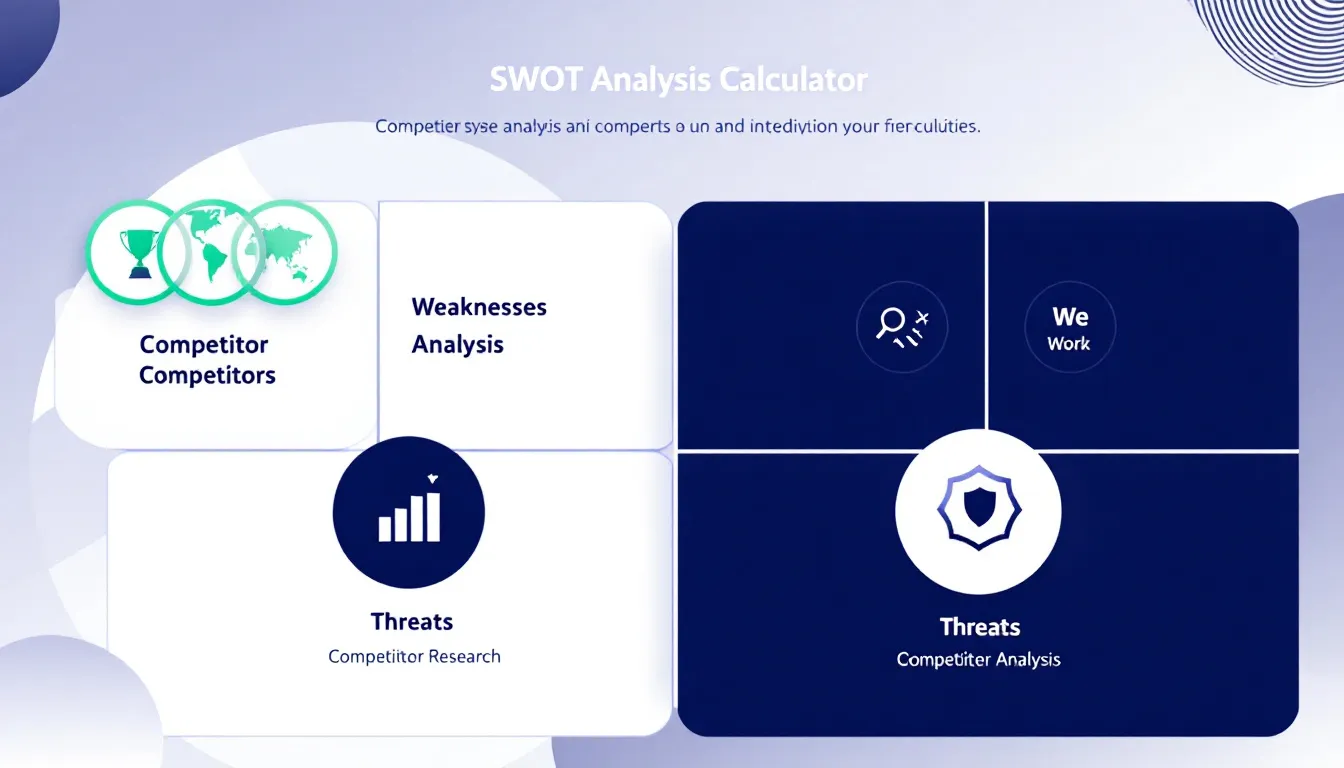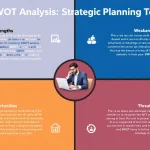Is this tool helpful?
How to Use the SWOT Analysis Calculator Effectively
This comprehensive SWOT analysis calculator streamlines the process of analyzing your company and its competitors. Here’s a detailed guide on using each field:
Step-by-Step Usage Guide
- Company Name: Enter your company’s full legal name (e.g., “Tesla Motors, Inc.” or “Nike Corporation”)
- Industry or Market Sector: Specify your primary industry (e.g., “Automotive Manufacturing” or “Sports Apparel”)
- Top 3 Competitors: List your main competitors, one per line (e.g., for Tesla: “Ford Motors, General Motors, Volkswagen”)
Understanding SWOT Analysis Calculator
A SWOT analysis calculator is a strategic planning tool that helps businesses systematically evaluate their competitive position by identifying Strengths, Weaknesses, Opportunities, and Threats. This digital tool transforms traditional manual analysis into an automated, data-driven process that delivers consistent and comprehensive results.
Core Components of SWOT Analysis
- Strengths: Internal positive attributes and resources
- Weaknesses: Internal limitations and challenges
- Opportunities: External factors that could benefit the business
- Threats: External elements that could harm the business
Benefits of Using the SWOT Analysis Calculator
Time and Resource Optimization
- Reduces analysis time from hours to minutes
- Eliminates manual data compilation and organization
- Ensures consistent evaluation criteria across multiple analyses
Enhanced Decision Making
- Provides structured comparison framework
- Facilitates data-driven strategic planning
- Enables quick competitive benchmarking
Competitive Intelligence
- Systematic competitor evaluation
- Market positioning insights
- Strategic gap identification
Solving Business Challenges Through SWOT Analysis
Market Entry Assessment
Consider a startup fintech company, “PaySecure,” analyzing its position against established players:
- Strengths: Advanced encryption technology, lower transaction fees
- Weaknesses: Limited market presence, small customer base
- Opportunities: Growing digital payment market, untapped rural sectors
- Threats: Established competitors, regulatory changes
Product Development Strategy
Example: “GreenGrow Organics” evaluating its position in the organic food market:
- Strengths: Certified organic processes, local supplier network
- Weaknesses: Higher production costs, limited shelf life
- Opportunities: Rising health consciousness, e-commerce expansion
- Threats: Climate change impact, increasing competition
Practical Applications and Use Cases
Strategic Planning
Organizations use SWOT analysis for annual strategic planning, mergers and acquisitions evaluation, and market expansion decisions.
Competitive Analysis
Regular monitoring of competitive landscape helps identify market gaps and opportunities for differentiation.
Risk Assessment
identifying potential threats enables proactive risk management and contingency planning.
Innovation Planning
SWOT analysis guides R&D investment decisions by highlighting technological strengths and market opportunities.
Industry-Specific Applications
Retail Sector
- Location analysis for new stores
- E-commerce integration strategy
- Supply chain optimization
Technology Industry
- Product feature development
- Market penetration strategy
- Technical talent acquisition
Healthcare Services
- Service expansion planning
- Quality improvement initiatives
- Patient care enhancement
Frequently Asked Questions
How often should I conduct a SWOT analysis?
Conduct SWOT analysis quarterly for dynamic industries and semi-annually for stable markets. Additional analysis is recommended before major business decisions or market changes.
Can SWOT analysis be used for departments within an organization?
Yes, SWOT analysis is effective for evaluating individual departments, projects, or product lines within an organization.
What makes a good SWOT analysis?
A good SWOT analysis is specific, measurable, and actionable. It should include concrete examples and data points rather than general statements.
How can I prioritize SWOT findings?
Prioritize findings based on their potential impact on business objectives and the feasibility of addressing them. Focus on high-impact, achievable actions first.
Should I include financial metrics in SWOT analysis?
Yes, incorporate relevant financial metrics like market share, revenue growth, and profitability when available to support your analysis.
How do I translate SWOT findings into action plans?
Create strategic initiatives that leverage strengths to capture opportunities while addressing weaknesses and mitigating threats. Develop specific action items with timelines and responsibilities.
Can SWOT analysis be used for personal development?
Yes, SWOT analysis is valuable for personal career planning, skill development, and professional growth strategies.
How detailed should competitor analysis be?
Include key metrics, market positioning, competitive advantages, and notable weaknesses while maintaining focus on actionable insights.
Important Disclaimer
The calculations, results, and content provided by our tools are not guaranteed to be accurate, complete, or reliable. Users are responsible for verifying and interpreting the results. Our content and tools may contain errors, biases, or inconsistencies. We reserve the right to save inputs and outputs from our tools for the purposes of error debugging, bias identification, and performance improvement. External companies providing AI models used in our tools may also save and process data in accordance with their own policies. By using our tools, you consent to this data collection and processing. We reserve the right to limit the usage of our tools based on current usability factors. By using our tools, you acknowledge that you have read, understood, and agreed to this disclaimer. You accept the inherent risks and limitations associated with the use of our tools and services.







